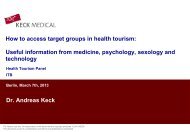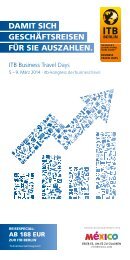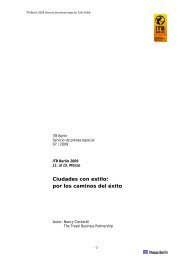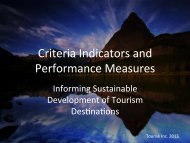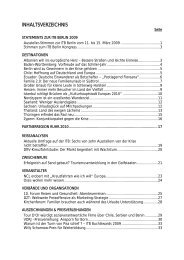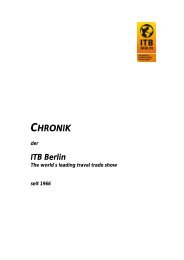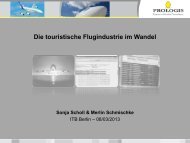Daily 12 March/März - ITB Berlin
Daily 12 March/März - ITB Berlin
Daily 12 March/März - ITB Berlin
Sie wollen auch ein ePaper? Erhöhen Sie die Reichweite Ihrer Titel.
YUMPU macht aus Druck-PDFs automatisch weboptimierte ePaper, die Google liebt.
XVI Friday <strong>12</strong> <strong>March</strong> <strong>ITB</strong> <strong>Berlin</strong> English <strong>Daily</strong> 2010<br />
Equator Asia comes to life<br />
‘Equator Asia’ has been adopted as the new marketing name for the special economic<br />
region which includes Southern Philippines, East Malaysia and Indonesia’s Kalimantan,<br />
the islands of Celebes, Moluccas and Papua. Officially, the region is known as BIMP-<br />
EAGA – an acronym that has proved far too complicated and unmemorable for a<br />
tourism destination. But, with the help of Germany’s Federal Ministry for Co-operation<br />
and Development, the region will now be rebranded and marketed as ‘Equator Asia’.<br />
For Peter Richter, BIMP-EAGA’s principal adviser in charge of the promotion of economic<br />
co-operation, the brand ‘Equator Asia’ has the dual advantage of both defining the area<br />
geographically and also giving it an aura of mystery and exoticism.<br />
‘Equator Asia’ will try to convey an image of another Asia, linked to biodiversity and<br />
environment. The slogan ‘the heart of biodiversity to the world’ has been chosen as the<br />
region has some of the best-preserved rainforests on earth, offering unique flora and<br />
fauna, says the team behind the project. A website (www.equator-asia.com) will be fully<br />
operational before the end of 2010.<br />
The BIMP-EAGA member countries have agreed to improve access to the region, and<br />
are encouraging airlines to offer international flights between the largest cities of<br />
‘Equator Asia’. Malaysia Airlines is likely to use its regional subsidiary MASwings to link<br />
Kuching and Kota Kinabalu (East Malaysia) with Pontianak and Balikpapan in Indonesia,<br />
and Davao and Zamboanga in the Philippines and with Brunei.<br />
Malaysia happy with its 2009 performance<br />
No Minister of Tourism would miss the opportunity of coming to <strong>ITB</strong> to support its<br />
tourism industry, and Dato Yen Yen Ng, Malaysia’s current Tourism Minister, is no<br />
exception. She told <strong>ITB</strong> delegates on the opening day that she is very satisfied with<br />
Malaysia’s 2009 performance. Despite the economic crisis, she said, the country<br />
recorded the best performance of any ASEAN country, with the exception of Myanmar.<br />
Malaysia welcomed 22.7 million tourist arrivals in 2009, an impressive increase of 7.2%.<br />
Regional markets contributed the bulk of visitors with Singapore alone representing<br />
<strong>12</strong>.7 million arrivals, followed by Indonesia (2.4 million) and Thailand (1.5 million).<br />
“This result is due to our efforts in aggressively promoting Malaysia as one of the preferred<br />
holiday destinations in the region. I am also very pleased to see that China broke<br />
the one million mark for the first time,” said the Minister.<br />
Malaysia will continue to use its slogan ‘Malaysia, Truly Asia’ this year, but it has added<br />
the tag line ‘It’s all here’ to emphasise the diversity of landscape, culture and food to be<br />
experienced. Tourism Malaysia is also focusing on more high-end tourists, developing<br />
niche products such as health tourism, homestays and second homes.<br />
The Health Ministry of Malaysia launched a new logo ‘Malaysia Healthcare’ last year,<br />
together with a website to promote medical tourism, drawing attention to the quality of<br />
the facilities offered by Malaysian healthcare and to the wide range of treatment<br />
options. Thirty-six private hospitals in the country have been selected to promote the



